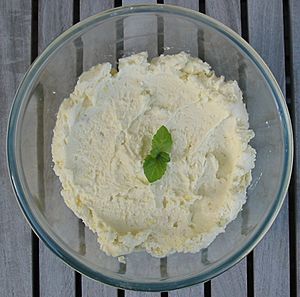Syllabub facts for kids
 |
|
| Course | Dessert |
|---|---|
| Place of origin | Cornwall |
| Main ingredients | Milk or cream, sugar, wine |
Syllabub is a sweet and frothy dessert from Cornish cuisine. It's made by mixing sweet cream or milk with something sour, like wine or cider. This old-fashioned treat was very popular between the 16th and 19th centuries.
Long ago, syllabub was often a drink made with cider and milk. Over time, it changed into a dessert. People started making it with sweet white wine. You could add more wine to make it like a punch. Or, it could be made thicker to eat with a spoon. Sometimes, it was used as a topping for trifle or with sponge cake. This sweet, bubbly punch was often seen as a "ladies' drink" during holidays.
A Sweet History
Syllabub has been known in England for a very long time. It was mentioned in a play around 1537. The famous diarist Samuel Pepys wrote about enjoying a "Sullybub" in 1663. It even appeared in a book called Tom Brown at Oxford in 1861.
How It Was Made
In the 18th century, a well-known cookbook author named Hannah Glasse shared a recipe for "whipt syllabubs." Her recipe used:
- A quart of thick cream
- Half a pint of sack (a type of wine)
- The juice of two Seville oranges or lemons
- Grated peel from two lemons
- Half a pound of refined sugar
She instructed people to whip all these ingredients together. Then, they would pour the mixture into glasses. The cream would curdle and float to the top, creating a lovely frothy layer.
See also
 In Spanish: Syllabub para niños
In Spanish: Syllabub para niños

